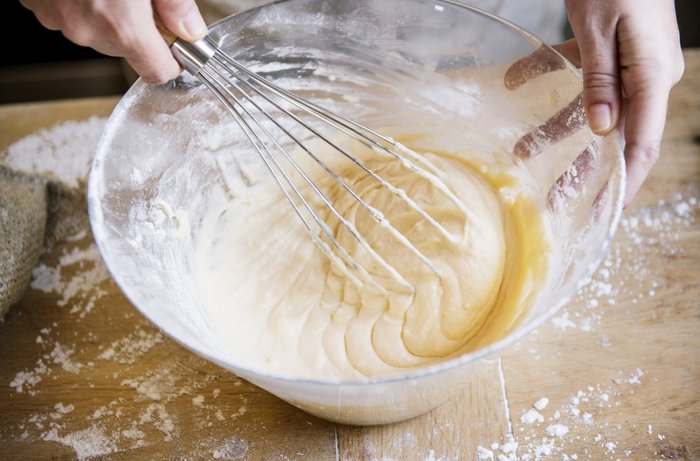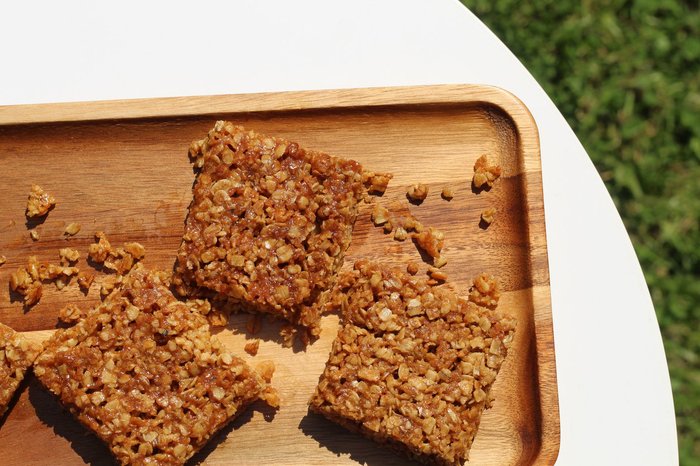Cakes, muffins, and other treats can be off the menu when you’re living with kidney disease, especially if you're been advised to eat less phosphate in your diet. Shop-bought baked goods are often high in phosphate additives. Home baking gives you control over the ingredients, but before you grab your whisk, there are a few things to know.
“Many shop-bought baked goods contain phosphate additives – even organic ones. You can find out if you look at the label of any processed food products,” explains Teresa Howes, who worked as a kidney dietitian in the NHS for 22 years and is now a lecturer training future dietitians. “Phosphates in additives like these are easily absorbed, compared to natural phosphates, so always look at the label of any processed food products.”
Phosphate additives are listed under different names, such as phosphoric acid or disodium phosphate. A good tip is to look for the letters ‘phos’ in the ingredients list, as well as the E numbers E450 or E341. “There are many more E numbers which relate to phosphate additives, but these two are the most common in baked goods,” says Teresa.
Baking your own favourite treats is a smart alternative, but you still need to be label savvy, as two staples in the home-baker’s pantry – self-raising flour and baking powder – also contain phosphate additives. (In some countries, baking powder doesn’t contain phosphate additives, but in the UK it does.)

Make your own kidney-friendly baking powder
Cakes need something to help them rise. In baking powder this is usually bicarbonate of soda, plus a mildly acidic phosphate salt. Together, the two create bubbles which help cakes rise. Thankfully, there’s an easy alternative if you are limiting the phosphates in your diet.
“You can make your own low-phosphate baking powder using cream of tartar and bicarbonate of soda,” says Teresa. Use two parts cream of tartar to one part bicarbonate of soda (bicarb). If you’re adding them straight to your dry ingredients, replace each teaspoon of baking powder in the recipe with ½ teaspoon of cream of tartar and ¼ teaspoon of bicarb.
You can also make a bigger batch of homemade baking powder to keep in an air-tight container, using two parts cream of tartar to one part bicarb and one part plain flour or cornflour. (The flour is there to help the mixture stay dry.) Use one teaspoon of this mix to replace 1 teaspoon of baking powder in a recipe.
Baking with homemade baking powder
Start with something simple that you’ve made before – a classic Victoria sandwich or a chocolate sponge cake, perhaps. This will help you get used to baking with homemade baking powder. Make sure your butter and eggs are at room temperature, as bicarb won’t work as well with fridge-cold ingredients.
Easy bakes like tea loaves or muffins are a great option for inexperienced bakers, plus they’re a nifty way of working more fruit and veg into your diet. Fold blueberries or raspberries into muffins or try bakes with hidden veggies like chocolate beetroot cake, classic carrot cake, a courgette loaf in summer or pumpkin muffins in autumn.
Kidney-friendly baking techniques
Experienced bakers might want to try a Genoise sponge. The Genoise technique doesn’t use baking powder, relying on vigorous whisking to add lots of air to the batter to help the cake rise.
Angel food cake is a similar, American bake which is made without butter. Instead, you whip egg whites and cream of tartar for a light, delicate sponge.
These cakes are more temperamental than a classic sponge and can be trickier to master, but the results are worth it!
Kidney-friendly baking ingredients
If you would rather not use cream of tartar, as it contains a little potassium, there are other mildly acidic ingredients that help bicarb to get bakes to rise, too.
To make American-style pancakes or fluffy scones, use buttermilk in the batter as well as bicarb. Plain yogurt works if you don’t have buttermilk.
Lemon juice or white wine vinegar plus bicarb is another clever combo, popular in vegan baking.
Teresa recommends the following kidney-friendly formula:
- Replace 120g self-raising flour with 120g plain flour.
- Add ½ teaspoon bicarb.
- Then you will need, at least, either 250ml of buttermilk, or 250g yogurt, or 1 teaspoon of lemon juice or 1 teaspoon of vinegar.
These ingredients may already be in your recipe. If not, you can swap them in for some of the wet ingredients.
Finally, there are plenty of bakes that don’t need a lift. Many biscuit recipes don’t use baking powder or self-raising flour, and neither do oaty flapjacks or crêpe-style pancakes.
Whether you’re an experienced baker or cake-making newbie, have fun experimenting and you’re bound to discover some new favourite treats.
